|
Franciacorta and Prosecco di Valdobbiadene certainly are the most famous
Italian sparkling wines in the world. Representatives of Italian bubbles - not
the only ones, of course - they express different productive methods and
styles: the former is the result of classic method, the latter of the
refermentation in closed tank. Two different methods producing results quite
distant one from each other, respectively capable of enhancing particular wine
making characteristics and styles. We cannot in fact talk - and it would not
make much sense - which one is the best of the two, as each of them has its
own characteristics capable of enhancing specific wine making techniques.
Likewise, both classic method and the refermentation in closed tank give
appreciable results with specific grapes only, not usable, in qualitative
terms, with both methods.
The refermentation in closed tank enhances the aromatic characteristics of
grapes, whereas the classic method is best suited for the production of
sparkling wines having a good body and sensorial complexity. For this reason,
the grapes generally used for the refermentation in closed tank are
characterized by a strong or however remarkable aromatic profile. It is not by
chance with this method are produced the famous Asti - using Muscat Blanc grape
- and Prosecco di Valdobbiadene, made with the grape having the same name, to
which is today preferred the old name “Glera”. The classic method is mainly
used with grapes capable of making wines with a good body and non particularly
aromatic, including Chardonnay, Pinot Noir and Pinot Blanc. Production times
are quite different in both cases: few months for the refermentation in closed
tank, at least one year for classic method, a period which is however
considered - in this case - very short.
Two different methods, perfectly suited for a tasting by contrast. Before
starting the evaluation of wines, let's understand - in general terms - the
productive characteristics of the two methods. The refermentation in closed
tank is widely used for the production of countless sparkling wines, in which
are mainly enhanced the young and fresh aromatic profile of grapes and wines.
The method was invented and patented by Federico Martinotti in 1895, at that
time headmaster of Experimental Wine Making School of Asti. The method was then
revised in 1910 by French Eugène Charmat and, after his improvement, became
common and credited to him. This technique has then been revised and improved
in 1970 by Italian Nereo Cavazzani, by introducing agitators in order to obtain
a deeper complexity and allowing longer production times. The method is today
known as “Martinotti-Charmat”, as well as “Italian method”, “Martinotti
method” and, finally, “Charmat method”.
The production of a sparkling wine by using this method generally provides for
the use of a base wine and then put in a closed tank, therefore an air tight
container. It is also added a mixture of yeast, an operation favoring the
beginning of a second fermentation of wine. Because of the tank's air
tightness, carbon dioxide is trapped inside the container and therefore gets
solubilized in wine and giving origin to the characteristic effervescence. The
fermentation generally ends in twenty days, whereas the whole process has a
variable duration according to the type of wine to be produced. “Short
Charmat” has a duration of three months, whereas by doubling this time - six
months - the method is called “long Charmat”, used for the production of wine
having a deeper complexity. The method invented by Cavazzeni provides for
longer times which can also be of 12 months, therefore increasing both the
structure of wine and the organoleptic complexity.
The production of a sparkling wine using the classic method is older and
provides for the refermentation of a base wine inside a bottle. The method
became famous in the world thanks to Champagne and it is in France known as
méthode champenoise, whereas in Italy it is called “traditional
method” or “Benedictine method”. To the base wine is added a mixture of
selected yeast and then put inside a bottle capable of standing high pressure.
The characteristic of the classic method consists in a long period of
refermentation and aging in the bottle and this is what gives the wine a deeper
complexity. This period can also last many years, however it is rare to be
shorter than twelve months. Yeast, at the end of fermentation, undergoes a
process of decomposition and release to the wine its own sensorial
characteristics, therefore increasing body.
|
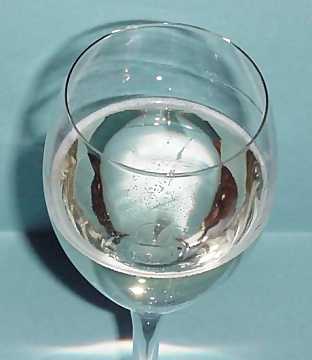 | |
| The perlage of a sparkling wine
produced with the method of refermentation in a closed tank | |
|
The bottle is therefore opened - an operation called disgorging - it is
removed the sediment produced by the yeast, for the style where this practice
is needed, it is added the so called liqueur d'expédition, therefore
capped with the classic mushroom shaped cork. A fundamental role in the
definition of a classic method's character is played by the liqueur
d'expédition, defining, among the other things, sweetness of wine. Produced
with secret recipes and characterizing each producer, it is generally made of
wine and sugar - sometimes grape brandy as well - and frequently wines aged in
cask or barrique. The adding of this mixture is called dosage and its
use is not provided for pas dosé or nature styles, as these wines
are absolutely dry and, like to say, non corrected. The adding of
liqueur d'expédition allows in fact producers to correct some sensorial
characteristics of a wine: quality pas dosé classic method sparkling
wines require - as a matter of fact - impeccable production techniques.
In case you need to know more about the respective production techniques, we
invite our readers to read our past reports dedicated to these subjects. Our
tasting by contrast will examine a “non vintage” Franciacorta Brut and
produced with the typical three grapes allowed by the disciplinary: Chardonnay,
Pinot Noir and Pinot Blanc. On this regard, it should be noticed the production
disciplinary of Franciacorta provides for a minimum aging on lees for at least
18 months, it is however not uncommon to have longer times. In choosing a
Prosecco di Valdobbiadene we will pick one made with 100% Glera grape, while
noticing in the production of this wine can also be used other varieties,
including Verdiso and Perera. We will choose an Extra Dry style, the most
common sweetness style for this wine. The sensorial tasting will be done in two
distinct glasses and the wines served at a temperature of 10 °C (50 °F), in
order to enhance - as much as possible - the respective olfactory profiles
while ensuring a good development of effervescence.
Let's pour the two wines in their glasses and let's start our comparative
tasting by proceeding with the evaluation of appearance. One of the specific
characteristics of this type of wines is represented by effervescence, in
particular the development of bubbles. The first contrast we will notice from
the observation of the two glasses is in fact relative to bubble size and
their development. Sparkling wines produced with the method of refermentation
in closed tank show, in general terms, bigger bubbles than those produced with
the classic method. We will also notice differences on the development of
effervescence: neat and linear in Franciacorta, quicker and “frenzy” in
Prosecco. Because of production times, definitely longer in Franciacorta, the
color of Prosecco shows nuances of greenish yellow, a quality hardly seen in
Franciacorta.
Contrasts are evidently detected to the nose as well. In general terms,
aromatic or semi-aromatic varieties are well suited to the refermentation in
closed tank, therefore Prosecco is certainly suited to this type of technique.
Grapes with a lower aromatic strength - however capable of making wines with a
good body - are best suited to the refermentation in bottle. It should be said
also the refermentation in a closed tank can be used for the making of wines
aged for a long time, a characteristic giving a fuller structure and olfactory
complexity. Sensorial complexity is however a characteristic of classic method
- provided it is allowed a proper aging in bottle prior to disgorging - in
which the decomposition of yeast plays a fundamental role. This productive
peculiarity makes classic method not very suited to aromatic varieties because
their characteristic aromas would be lost or substantially changed.
Let's start the evaluation of aromas in Prosecco di Valdobbiadene. By keeping
the glass in vertical position and without swirling, let's proceed with the
analysis of opening aromas. The olfactory profile of this wine is mainly
oriented to sensations of fruit and flowers, in particular pear, apple,
wistaria and broom. The opening of Franciacorta expresses different aromas,
more complex than Prosecco. From the glass will be perceived sensations of
apple, bread crust, yeast and banana, sometimes hazelnut. Let's proceed with
the swirling of the glasses in order to favor the development of the remaining
olfactory characteristics. Prosecco proceeds its olfactory sequence with
sensations recalling fruits and flowers, in particular pineapple, hawthorn and
plum, including hints of citrus fruits and tropical fruits. The development of
Franciacorta proceeds with complex sensations as well as fruits, such as plum,
pear, butter, praline, grapefruit, croissant and citrus fruit peel.
Contrasts continues, inevitably, to the gustatory analysis as well. Let's taste
Prosecco di Valdobbiadene: in the mouth is confirmed the profile of fruits
already perceived to the nose - apple, pear and peach - with an effervescent
attack followed by a moderate sweetness and live crispness. The structure is of
moderate body and, sometimes, even light body. Let's now evaluate Franciacorta:
the attack is effervescent and crisp, with an impact of carbon dioxide less
aggressive than the previous wine. The taste is dry with a slight hint of
sweetness, however balanced by acidity. The structure, compared to Prosecco,
has an evident fuller body. Moreover, it will be perceived a rounder sensation:
not only the sign of a longer aging, but also the contribution of yeast and the
typical varieties used for the production of this wine.
The final phase of the tasting, in which are being evaluated the sensations
produced in the mouth by the wines after having swallowed them, continues to
reveal the contrasts between Franciacorta and Prosecco di Valdobbiadene. Both
wines - in general terms - are characterized by an evident long persistence,
therefore confirming the quality for which they are known. The finish of
Prosecco di Valdobbiadene gives the mouth a lighter sensation than
Franciacorta, as well as a hint of sweetness, totally absent in the famous
classic method from Lombardy. Prosecco di Valdobbiadene is characterized by
flavors of fruits, the same ones perceived to the nose, whereas Franciacorta
gives a more complex and rounder profile. Two totally different ways of making
sparkling wines, two ways of interpreting bubbles, sometimes opposite, both in
productive terms and for the different organoleptic characteristics.
|


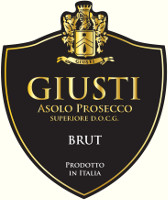
 Glera
Glera Brilliant greenish yellow and nuances of greenish yellow, very
transparent, fine and persistent perlage.
Brilliant greenish yellow and nuances of greenish yellow, very
transparent, fine and persistent perlage.
 Intense, clean, pleasing and refined, starts with hints of apple, pear
and wistaria followed by aromas of peach, hawthorn, pineapple, citrus
fruits and broom.
Intense, clean, pleasing and refined, starts with hints of apple, pear
and wistaria followed by aromas of peach, hawthorn, pineapple, citrus
fruits and broom.
 Effervescent and crisp attack, however balanced by alcohol, light body,
intense flavors, agreeable.
Effervescent and crisp attack, however balanced by alcohol, light body,
intense flavors, agreeable.
 Persistent finish with flavors of apple, pear and peach.
Persistent finish with flavors of apple, pear and peach. Fermented in closed tank.
Fermented in closed tank. Aperitifs, Dairy products, Risotto with crustaceans and vegetables, Eggs
Aperitifs, Dairy products, Risotto with crustaceans and vegetables, Eggs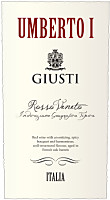
 Merlot, Cabernet Sauvignon
Merlot, Cabernet Sauvignon Intense ruby red and nuances of garnet red, little transparency.
Intense ruby red and nuances of garnet red, little transparency. Intense, clean, pleasing, refined and elegant, starts with hints of
black currant, plum and dried violet followed by aromas of blueberry,
tobacco, licorice, vanilla, chocolate, leather, mace and eucalyptus.
Intense, clean, pleasing, refined and elegant, starts with hints of
black currant, plum and dried violet followed by aromas of blueberry,
tobacco, licorice, vanilla, chocolate, leather, mace and eucalyptus.
 Properly tannic attack and however balanced by alcohol, good body,
intense flavors, pleasing roundness.
Properly tannic attack and however balanced by alcohol, good body,
intense flavors, pleasing roundness.
 Persistent finish with flavors of black currant, plum and black
cherry.
Persistent finish with flavors of black currant, plum and black
cherry.
 30 months in barrique.
30 months in barrique. Roasted meat, Stewed and braised meat with mushrooms, Hard cheese
Roasted meat, Stewed and braised meat with mushrooms, Hard cheese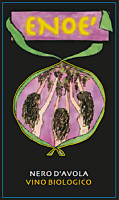
 Nero d'Avola
Nero d'Avola Intense ruby red and nuances of ruby red, little transparency.
Intense ruby red and nuances of ruby red, little transparency. Intense, clean and pleasing, starts with hints of plum, black cherry
and blackberry followed by aromas of violet, blueberry and geranium.
Intense, clean and pleasing, starts with hints of plum, black cherry
and blackberry followed by aromas of violet, blueberry and geranium.
 Properly tannic attack and however balanced by alcohol, good body,
intense flavors.
Properly tannic attack and however balanced by alcohol, good body,
intense flavors.
 Persistent finish with flavors of plum, black cherry and blackberry.
Persistent finish with flavors of plum, black cherry and blackberry. 6 months in steel tanks, 6 months in bottle.
6 months in steel tanks, 6 months in bottle. Stuffed pasta, Broiled meat and barbecue, Stewed meat with mushrooms
Stuffed pasta, Broiled meat and barbecue, Stewed meat with mushrooms
 Passerina
Passerina Pale straw yellow and nuances of greenish yellow, very transparent.
Pale straw yellow and nuances of greenish yellow, very transparent. Intense, clean, pleasing and refined, starts with hints of apple, peach
and pineapple followed by aromas of pear, citrus fruits, hawthorn, broom
and plum.
Intense, clean, pleasing and refined, starts with hints of apple, peach
and pineapple followed by aromas of pear, citrus fruits, hawthorn, broom
and plum.
 Crisp attack and however balanced by alcohol, good body, intense
flavors, pleasing roundness.
Crisp attack and however balanced by alcohol, good body, intense
flavors, pleasing roundness.
 Persistent finish with flavors of apple, pineapple and peach.
Persistent finish with flavors of apple, pineapple and peach. Aged in steel tanks.
Aged in steel tanks. Pasta with fish and mushrooms, Stewed fish, Mushroom soups
Pasta with fish and mushrooms, Stewed fish, Mushroom soups
 Montepulciano (65%), Sangiovese (25%), Cabernet Sauvignon (10%)
Montepulciano (65%), Sangiovese (25%), Cabernet Sauvignon (10%) Intense ruby red and nuances of garnet red, little transparency.
Intense ruby red and nuances of garnet red, little transparency. Intense, clean, pleasing and refined, starts with hints of plum, black
cherry and black currant followed by aromas of dried violet, blueberry,
vanilla, tobacco, chocolate and menthol.
Intense, clean, pleasing and refined, starts with hints of plum, black
cherry and black currant followed by aromas of dried violet, blueberry,
vanilla, tobacco, chocolate and menthol.
 Properly tannic attack and however balanced by alcohol, good body,
intense flavors, agreeable.
Properly tannic attack and however balanced by alcohol, good body,
intense flavors, agreeable.
 Persistent finish with flavors of plum, black cherry and black currant.
Persistent finish with flavors of plum, black cherry and black currant. 14 months in cask, 6 months in bottle.
14 months in cask, 6 months in bottle. Broiled meat and barbecue, Stewed meat with mushrooms, Hard cheese
Broiled meat and barbecue, Stewed meat with mushrooms, Hard cheese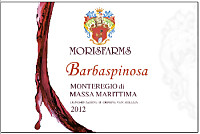
 Sangiovese (90%), Cabernet Sauvignon (10%)
Sangiovese (90%), Cabernet Sauvignon (10%) Brilliant ruby red and nuances of garnet red, little transparency.
Brilliant ruby red and nuances of garnet red, little transparency. Intense, clean, pleasing and refined, starts with hints of black
cherry, plum and black currant followed by aromas of violet, blueberry,
cyclamen, vanilla, tobacco, chocolate and menthol.
Intense, clean, pleasing and refined, starts with hints of black
cherry, plum and black currant followed by aromas of violet, blueberry,
cyclamen, vanilla, tobacco, chocolate and menthol.
 Properly tannic attack and however balanced by alcohol, good body,
intense flavors, agreeable.
Properly tannic attack and however balanced by alcohol, good body,
intense flavors, agreeable.
 Persistent finish with flavors of black cherry, plum and black currant.
Persistent finish with flavors of black cherry, plum and black currant. 12 months in barrique.
12 months in barrique. Roasted meat, Stewed and braised meat with mushrooms, Hard cheese
Roasted meat, Stewed and braised meat with mushrooms, Hard cheese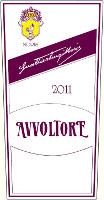
 Sangiovese (75%), Cabernet Sauvignon (20%), Syrah (5%)
Sangiovese (75%), Cabernet Sauvignon (20%), Syrah (5%) Deep ruby red and nuances of garnet red, little transparency.
Deep ruby red and nuances of garnet red, little transparency. Intense, clean, pleasing, refined and elegant, starts with hints of
black cherry, black currant and plum followed by aromas of violet,
blueberry, blackberry, vanilla, face powder, cocoa, tobacco, cinnamon, mace
and eucalyptus.
Intense, clean, pleasing, refined and elegant, starts with hints of
black cherry, black currant and plum followed by aromas of violet,
blueberry, blackberry, vanilla, face powder, cocoa, tobacco, cinnamon, mace
and eucalyptus.
 Tannic attack and however balanced by alcohol, full body, intense
flavors, agreeable.
Tannic attack and however balanced by alcohol, full body, intense
flavors, agreeable.
 Very persistent finish with long flavors of black cherry, black currant
and plum.
Very persistent finish with long flavors of black cherry, black currant
and plum.
 12 months in barrique, 6 months in bottle.
12 months in barrique, 6 months in bottle. Game, Roasted meat, Braised and stewed meat, Hard cheese
Game, Roasted meat, Braised and stewed meat, Hard cheese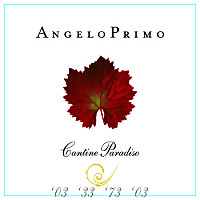
 Uva di Troia
Uva di Troia Intense ruby red and nuances of garnet red, little transparency.
Intense ruby red and nuances of garnet red, little transparency. Intense, clean, pleasing and refined, starts with hints of black
cherry, blueberry and blackberry followed by aromas of plum, dried violet,
tobacco, carob, chocolate, vanilla and menthol.
Intense, clean, pleasing and refined, starts with hints of black
cherry, blueberry and blackberry followed by aromas of plum, dried violet,
tobacco, carob, chocolate, vanilla and menthol.
 Properly tannic attack and however balanced by alcohol, good body,
intense flavors, pleasing roundness.
Properly tannic attack and however balanced by alcohol, good body,
intense flavors, pleasing roundness.
 Persistent finish with flavors of black cherry, plum and blackberry.
Persistent finish with flavors of black cherry, plum and blackberry. 12 months in barrique, 3 months in steel tanks, 4 months in bottle.
12 months in barrique, 3 months in steel tanks, 4 months in bottle. Broiled meat and barbecue, Roasted meat, Stewed meat, Hard cheese
Broiled meat and barbecue, Roasted meat, Stewed meat, Hard cheese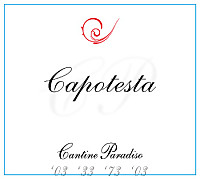
 Primitivo
Primitivo Intense ruby red and nuances of garnet red, little transparency.
Intense ruby red and nuances of garnet red, little transparency. Intense, clean, pleasing and refined, starts with hints of plum,
blackberry and black cherry followed by aromas of dried violet, blueberry,
vanilla, chocolate, tobacco, cinnamon, mace and menthol.
Intense, clean, pleasing and refined, starts with hints of plum,
blackberry and black cherry followed by aromas of dried violet, blueberry,
vanilla, chocolate, tobacco, cinnamon, mace and menthol.
 Properly tannic attack and however balanced by alcohol, good body,
intense flavors, pleasing roundness.
Properly tannic attack and however balanced by alcohol, good body,
intense flavors, pleasing roundness.
 Persistent finish with flavors of plum, blackberry and black cherry.
Persistent finish with flavors of plum, blackberry and black cherry. 12 months in barrique, 5 months in steel tanks, 4 months in bottle.
12 months in barrique, 5 months in steel tanks, 4 months in bottle. Stuffed pasta with meat, Stewed meat, Broiled meat and barbecue, Roasted meat
Stuffed pasta with meat, Stewed meat, Broiled meat and barbecue, Roasted meat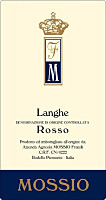
 Barbera (40%), Nebbiolo (40%), Dolcetto (20%)
Barbera (40%), Nebbiolo (40%), Dolcetto (20%) Brilliant ruby red and nuances of garnet red, little transparency.
Brilliant ruby red and nuances of garnet red, little transparency. Intense, clean, pleasing, refined and elegant, starts with hints of
plum, cherry and violet followed by aromas of raspberry, blueberry,
vanilla, rose, chocolate, pink pepper, face powder, tobacco and menthol.
Intense, clean, pleasing, refined and elegant, starts with hints of
plum, cherry and violet followed by aromas of raspberry, blueberry,
vanilla, rose, chocolate, pink pepper, face powder, tobacco and menthol.
 Properly tannic attack and however balanced by alcohol, good body,
intense flavors, pleasing crispness.
Properly tannic attack and however balanced by alcohol, good body,
intense flavors, pleasing crispness.
 Persistent finish with flavors of cherry, plum and raspberry.
Persistent finish with flavors of cherry, plum and raspberry. 12 months in cask, 2 months in bottle.
12 months in cask, 2 months in bottle. Roasted meat, Braised and stewed meat with mushrooms, Hard cheese
Roasted meat, Braised and stewed meat with mushrooms, Hard cheese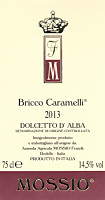
 Dolcetto
Dolcetto Deep ruby red and nuances of ruby red, little transparency.
Deep ruby red and nuances of ruby red, little transparency. Intense, clean, pleasing, refined and elegant, starts with hints of
cherry, blackberry and plum followed by aromas of violet, blueberry,
strawberry, raspberry, geranium, cyclamen, anise, almond and mint.
Intense, clean, pleasing, refined and elegant, starts with hints of
cherry, blackberry and plum followed by aromas of violet, blueberry,
strawberry, raspberry, geranium, cyclamen, anise, almond and mint.
 Properly tannic attack and however balanced by alcohol, good body,
intense flavors, agreeable.
Properly tannic attack and however balanced by alcohol, good body,
intense flavors, agreeable.
 Very persistent finish with long flavors of cherry, blackberry and
blueberry.
Very persistent finish with long flavors of cherry, blackberry and
blueberry.
 Aged in steel tanks.
Aged in steel tanks. Cold cuts, Pasta with meat and mushrooms, Roasted white meat, Sauteed meat
Cold cuts, Pasta with meat and mushrooms, Roasted white meat, Sauteed meat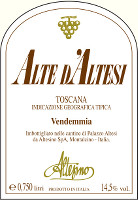
 Sangiovese, Cabernet Sauvignon, Merlot
Sangiovese, Cabernet Sauvignon, Merlot Intense ruby red and nuances of garnet red, little transparency.
Intense ruby red and nuances of garnet red, little transparency. Intense, clean, pleasing, refined and elegant, starts with hints of
black cherry, black currant and plum followed by aromas of violet,
blueberry, blackberry, vanilla, tobacco, chocolate, mace and menthol.
Intense, clean, pleasing, refined and elegant, starts with hints of
black cherry, black currant and plum followed by aromas of violet,
blueberry, blackberry, vanilla, tobacco, chocolate, mace and menthol.
 Tannic attack and however balanced by alcohol, good body, intense
flavors, pleasing roundness.
Tannic attack and however balanced by alcohol, good body, intense
flavors, pleasing roundness.
 Persistent finish with flavors of black cherry, black currant and plum.
Persistent finish with flavors of black cherry, black currant and plum. 14 months in barrique, 3 months in bottle.
14 months in barrique, 3 months in bottle. Roasted meat, Broiled meat and barbecue, Braised and stewed meat, Hard cheese
Roasted meat, Broiled meat and barbecue, Braised and stewed meat, Hard cheese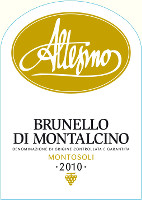
 Sangiovese
Sangiovese Intense ruby red and nuances of garnet red, moderate transparency.
Intense ruby red and nuances of garnet red, moderate transparency. Intense, clean, pleasing, refined and elegant, starts with hints of
black cherry, plum and raspberry followed by aromas of violet, blueberry,
dried rose, vanilla, tobacco, chocolate, licorice, cinnamon, pink pepper,
mace and menthol.
Intense, clean, pleasing, refined and elegant, starts with hints of
black cherry, plum and raspberry followed by aromas of violet, blueberry,
dried rose, vanilla, tobacco, chocolate, licorice, cinnamon, pink pepper,
mace and menthol.
 Tannic attack and however balanced by alcohol, full body, intense
flavors, agreeable.
Tannic attack and however balanced by alcohol, full body, intense
flavors, agreeable.
 Very persistent finish with long flavors of black cherry, plum and
raspberry.
Very persistent finish with long flavors of black cherry, plum and
raspberry.
 24 months in cask, 4 months in barrique, 4 months in bottle.
24 months in cask, 4 months in barrique, 4 months in bottle. Game, Roasted meat, Stewed and braised meat, Hard cheese
Game, Roasted meat, Stewed and braised meat, Hard cheese
